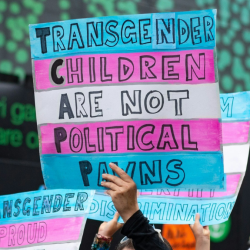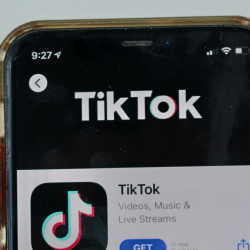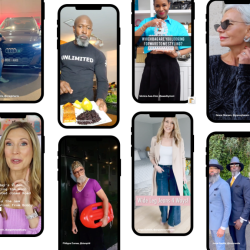Kristina is a seasoned international development and elections specialist. She co-founded #ShePersisted — a cross-national initiative to tackle gendered disinformation and online gender-based violence — and serves as the Global Democracy Advisor at Reset.Tech. We met her at 5th Polaris Leadership Summit after her ‘Winning the fight against disinformation’ panel.
Hi Kristina. Thanks for talking to us. Could you share some examples of effective strategies or initiatives you’ve implemented to counter disinformation in fragile environments? Why they were successful?

One essential aspect is recognizing the vital role of social media and digital platforms. Often, it can feel overwhelming to tackle disinformation, leading to a sense of helplessness. However, addressing this issue requires regulations that go beyond self-regulation and establishing laws pertaining to social media platforms. Currently, these platforms — which represented billion-dollar industries — tend to oppose such regulations and engage in soft capture, exploiting weak points in debates about free expression and freedom of speech, which are important democratic principles. Hence, the first step is to gain control over these predominantly US-based platforms, while acknowledging that this process will differ across various contexts. Localizing the discourse is essential, especially in countries where fair parliaments are unwilling to pass laws that grant them advantages within the information ecosystem. For instance, as I mentioned during my speech, a Kenyan-based group called the Council for Responsible Social Media, comprising individuals who aren’t tech experts but recognized the global inequities inherent in this issue.
Also, it’s crucial to address gaps in content moderation in different languages. By mapping and analysing this aspect, I found out that certain countries lack proper content moderation in their respective languages. For instance, in Ethiopia, where a full-blown civil war unfolded, or in parts of Kenya and East Africa, platforms didn’t adequately monitor content in Swahili. Without such measures in place, it becomes nearly impossible to curb the spread of disinformation or address criminal activities conducted through these platforms.
It’s imperative to treat online actions with the same legal ramifications as their offline counterparts. For example, if voyeurism is a crime offline, it should also be regarded as an offence online. These policies don’t infringe upon freedom of expression; rather, they ensure a safer digital environment. Therefore, establishing comprehensive policies is crucial.
In addition to regulatory efforts, market pressure plays a significant role. Advertisers are becoming increasingly aware of the brand implications associated with supporting platforms lacking appropriate guardrails. Major brands like Nike or Coca-Cola wouldn’t want their advertisements appearing alongside content that promotes anti-vaccination sentiments, incites violence, or contains neo-Nazi ideologies. Therefore, advertisers need to demand more accountability and transparency from the platforms regarding where their digital ads are placed. In the past, in traditional media, companies could request not to be featured next to certain types of content. However, in the digital world, advertisers often have no visibility or say in the matter unless they actively assert their preferences. We’ve witnessed a trend where advertisers have abandoned platforms like Twitter, not due to new legislation, but because it negatively impacted their brand reputation. When 50% of advertisers withdraw from a platform, it serves as a powerful mechanism for change.
Once these foundational aspects are addressed, we can focus on implementing counter disinformation strategies more directly. This involves developing offensive digital content to disrupt dangerous ideas and crafting narratives that challenge misinformation. Also, it entails targeting and engaging with specific audiences in ways that effectively address and mitigate disinformation.
The line between disinformation and free speech can sometimes be blurred. How do we strike a balance between combating disinformation and protecting individuals’ rights to express their opinions?
It is important to recognize that the debate around free expression is often framed falsely. In the context of my country, US, there is a radicalized focus on the First Amendment, which historically did not consider the speech of marginalized groups. We need to challenge this construct and address the intersection of ideas with white supremacy and misogyny that limits the voices being heard.
Also, it is important to distinguish between freedom of speech and freedom of reach. Platforms like Facebook (now Meta) have immense influence over our thoughts and behaviours, as highlighted by the Facebook whistleblower, Frances Haugen. They are aware that their products harm certain audiences, leading to mental health issues and even suicide, particularly on platforms like Instagram. Online harms, such as these, should be the focus of our efforts, rather than getting caught up in a broad argument about speech. Noise and information overload also contribute to limiting speech, which some refer to as censorship by noise. By managing and curbing unregulated content, we can address the volume of disinformation and ensure a more disciplined discourse about speech. It is also important to apply existing laws around criminal activities to the online world and have a nuanced policy discourse on when to be concerned about overreach and when to address the status quo.
As a co-founder of #ShePersisted, what challenges do women face in the context of disinformation, and how can we create more inclusive and supportive environments for political participation of women?
With #ShePersisted I have dedicated years to helping women enter politics and breaking the systemic barriers unique to their gender. Our efforts have been successful in addressing these challenges, whether through quota systems, reaching women as voters, or supporting women as political candidates. Despite progress, the rise of misinformation and disinformation undermines these achievements by weaponizing misogyny and bias against women.
In various contexts, women face specific challenges due to disinformation. For instance, in Italy, a former Minister of Education was targeted with misleading disinformation that distorted her stance on important societal debates, such as marriage and transgender rights. This manipulation aimed to radicalize certain audiences, perpetuating culture wars and impeding meaningful discussions on fundamental human rights.
Women are at the forefront of pro-democracy movements worldwide, tackling gender issues within these struggles. The spark for such movements can arise from seemingly small issues, such as women’s autonomy, dignity, respect, and attire. The largest protest movement in US history, the Women’s March in 2018, demonstrated the power of women’s mobilization. In conflict-ridden regions like Turkey, women have shown remarkable ability to bridge divides and overcome fault lines.

The targeting of women leaders with disinformation is not only an assault on their dignity, but also a threat to democracy and security. Attacks aimed at undermining women’s leadership often position them as unlikeable, untrustworthy, unqualified, or lacking control over their emotions. Sexualized content adds to the backdrop of these attacks, perpetuated by image-based media platforms.
The digital age, with advancements like artificial intelligence, has made it easier to generate attacks against women, exacerbating the challenges they face. Overcoming biases related to likeability, trust, qualifications, and competence is an ongoing struggle in both online and offline spaces. Biases and sexist content are strategically employed to manipulate public opinion.
To create more inclusive and supportive environments for women’s political participation, we need to dismantle patriarchal structures and challenge gendered disinformation. Women who oppose these structures often face opposition, but it is essential to recognize the significance of confronting gender-based biases and discrimination. By actively countering disinformation, promoting gender equality, and fostering open dialogue, we can strive towards a political landscape that values and respects the leadership of women.
As an Adjunct Professor teaching counter disinformation research and policy, what key skills or knowledge areas do you believe are crucial for future policymakers and professionals working in the field?
The course and teaching I’ve been doing aim to help students think about the larger information ecosystem that will impact everything we do in the future. Understanding the influence of information is essential for policy development, leadership choices, and career decisions. It is crucial for professionals, for example, to learn how to work with AI and navigate the information landscape effectively. Academic institutions should focus on equipping students with the necessary skills to analyse and combat disinformation, as it will be an integral part of their professional lives.
When I look at Gen Z and their engagement with the world and in politics and advocacy, everyone’s a bit depressed. How can we uplift and motivate them without compromising their authenticity? It’s important to recognize that hope is a choice, not just an emotion. To uplift Gen Z, we can draw inspiration from the strategic positioning of the Mayor of Istanbul, Ekrem Imamoglu, who emphasizes social cohesion, love, and our shared human experience. While it may be challenging to remain angry all the time, even extremists and white supremacists seek a way out of constant anger. Acknowledging the divisions between rural and urban communities, and addressing the needs of those who feel left behind can foster a sense of unity and empower young leaders to contribute to positive change.
Everyone should find their own pathway in addressing these challenges. While it may seem overwhelming, targeting efforts and finding ways to make a difference can be impactful. This can include using social media responsibly, consciously spreading positive content, avoiding pointless online conflicts, and not amplifying content that goes against one’s values. It’s not a one-size-fits-all strategy, but everyone should explore how they can be part of the solution and uphold democratic values in their own way.
Gen Z holds significant influence as a powerful consumer base. Brands and advertisers are paying attention to the way they navigate the world. Gen Z’s consciousness, sensitivity, and market power have disrupted traditional advertising formulas. This presents an opportunity for Gen Z to use their power to shape the advertising landscape and push for more responsible and ethical practices. By making conscious choices and expressing their values, they can drive positive change in the industry.
Featured image: Ari He / Unsplash































